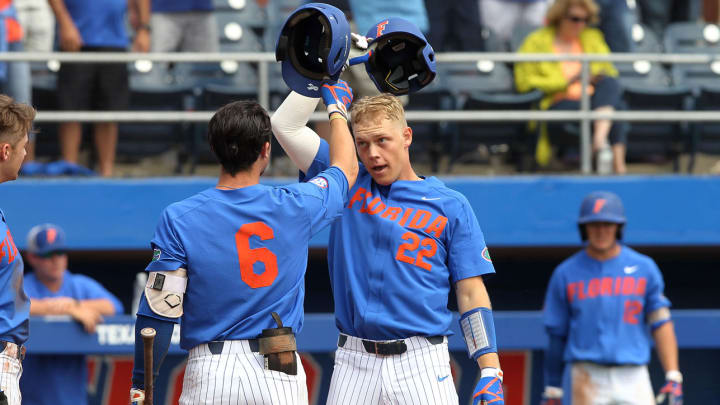Stetson, Florida Are Two Teams to Watch in the 2018 Journey to the College World Series

It may never reach the hype of its basketball analogue, but college baseball’s Selection Monday has grown into an event that conjures up enough drama and controversy to set the table for the NCAA tournament, which begins on Friday at 16 regional sites across the country. This year’s field is out, and there was no drama surrounding this year’s top seed: After bringing home the first national title in program history, Florida cruised through its 2018 season, emerging from the country’s toughest schedule with just one series loss, which itself only came with the SEC regular-season championship already clinched. The Gators are an early favorite to make it back to the College World Series for a fourth consecutive season, but the matters of who will join them there and what storylines and stars will take hold over the have yet to be decided.
As college baseball fans settle in to fill out their brackets and plot their own teams’ paths to Omaha this week, here are four lingering takeaways from the big reveal.
Hating on the Hatters: No team from the Atlantic Sun has ever earned a national seed and the Super Regional hosting rights that come with it, but Atlantic Sun champion Stetson appeared to have built the most compelling case yet with a 45–11 record that tied it with Clemson for the most wins in the country and a season-ending RPI of 4, below only top-seeded Florida, No. 2 seed Stanford and No. 5 seed Arkansas. Instead, the Hatters were passed over for the No. 8 seed in favor of Georgia—one of a whopping four SEC teams that earned a national seed—and ended up all the way down at No. 11, with a potential Super Regional trip to Chapel Hill and No. 6 North Carolina looming should they advance out of their home regional.
Yes, Stetson could have pumped up its chances with another win or two against ACC tournament champion Florida State, against which it went 1–2 in regular season play, but a brand-name program with an 8–3 record against the RPI top 50 wouldn’t have needed to win every single big game to make a sufficient impression. You may be familiar with the Hatters from program alumni such as Corey Kluber and Jacob deGrom, or from DeLand native and longtime supporter Chipper Jones, but in a few weeks’ time you may know them as the disrespected mid-majors taking shots at the bluebloods in Omaha.
Kentucky snubbed: The SEC is in no position to nitpick the selection committee’s decisions, with a record-tying 10 teams in the tournament and the aforementioned cluster of national seeds, but it was peculiar at best to see Kentucky omitted from the field. The Wildcats (RPI: 32) were the only team with a top-40 RPI to be left out and won 16 games against RPI top-50 opponents, but they spoiled their chance to improve on a 13–17 SEC record with an opening-day loss to Auburn in last week’s conference tournament. (Historically, the committee has been extremely hesitant to invite teams that finish under .500 in conference play; Texas A&M was the only team in the field with that distinction this year, and the Aggies needed a run to the semifinals in Hoover to play themselves off the bubble.)
The last four teams in the field—Dallas Baptist, Northeastern, Oklahoma State and Troy—feel like the committee was doing penance for the way it treated Stetson, packing in mid-major at-large bids at the expense of state schools like Arizona and Illinois. But with eight wins against Top 25 teams, Kentucky has a bigger gripe than most.
Early returns on a format change: For the first time, all 16 regional hosts were assigned seeds as part of the committee’s construction of the tournament field—in previous years only the eight national seeds were revealed, and Super Regional pairings were set by separating regional hosts from the same conference and sorting out the rest of the matchups largely by geography. This new format, in which the No. 1 seed’s regional lines up with the No. 16 seed’s and so on, disregards conference ties and appears to give the national seeds a draw closer to what they deserve.
The old system resulted in a lot of all-too-familiar Super Regional matchups: Florida–Florida State and Texas A&M–TCU series were each staged in back-to-back postseasons, to take two recent examples. But this new format hasn’t completely eliminated redundancy. The Clemson Regional (Clemson, Vanderbilt, St. John’s and Morehead State) has three out of the four teams that played there a year ago in the exact seeds they were assigned in 2017 (Clemson, Vanderbilt, St. John’s and UNC Greensboro).
Top seeds with the toughest roads to Omaha: Check back for a complete breakdown of all 16 regions, but it’s not too early to put Ole Miss, Texas Tech and Florida State on notice. The Rebels drew Tennessee Tech, owner of the nation’s No. 1 offense in terms of batting average, home runs and scoring, as their No. 2 seed in Oxford. The Red Raiders open up against a New Mexico State lineup that can score in bunches in its own right, with a spunky Louisville squad and a Kent State program with a College World Series trip in the not-too-distant past waiting in the wings later on in the weekend. And FSU will have to get past Oklahoma, with two outfielders eyeing first-round draft picks in Steele Walker and Kyler Murray, or Mississippi State, which just swept Florida two weekends ago.
